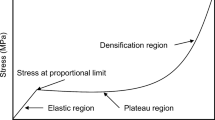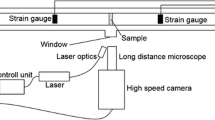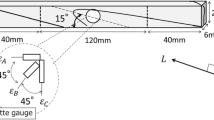Abstract
The influence of strain rate, moisture content and loading direction on the stress-strain relationships for spruce wood has been investigated. The strain rates were approximately 8×10−3 s−1, 17s−1 and 1000 s−1, and the states of moisture content were those corresponding to oven dry, fiber saturated and fully saturated. Compressive loads were applied along the principal directions of the stem of the tree, i.e., radially, tangentially and axially. The low and medium strain-rate tests were performed with the aid of a servohydraulic testing machine, while the high strain-rate tests were carried out using the split Hopkinson pressure bar (SHPB) technique. Magnesium or steel bars were used in the different SHPB tests in order to reduce impedance mismatch for the different directions of the wood specimens. The strain rate was found to have large influence on the behavior of the wood, especially under the condition of full saturation, where water transport in the deforming specimen is of major importance.
Similar content being viewed by others
References
Uhmeier, A. andSalmén, L., “Influence of Strain Rate and Temperature on the Radial Compression Behaviour of Wet Spruce”,Journal of Engineering Materials and Technology,118,289–294 (1996).
Renaud, M., Rueff, M., andRocaboy, A.C., “Mechanical Behaviour of Saturated Wood under Compression. Part 1. Behaviour of Wood at High Rates of Strain”,Wood Science and Technology,30,153–164 (1996).
Renaud, M., Rueff, M., andRocaboy, A.C., “Mechanical Behaviour of Saturated Wood under Compression. Part 2. Behaviour of Wood at Low Rates of Strain, Some Effects of Compression on Wood Structure”,Wood Science and Technology,30,237–243, (1996).
Bragov, A. andLomunov, A.K., “Dynamic Properties of Some Wood Species”,Journal de Physique IV,7 (C3),487–492 (1997).
Reid, S.R. andPeng, C., “Dynamic Uniaxial Crushing of Wood”,International Journal of Impact Engineering,19 (5–6),531–570 (1997).
Al-Mousawi, M.M., Reid, S.R., andDeans, W.F., “The Use of the Split Hopkinson Pressure Bar Techniques in High Strain-Rate Materials Testing”,Proceedings of the Institution of Mechanical Engineers,211 (C),273–292 (1997).
Widehammar, S., “Estimation of 3D Field Quantities and Energy Flux Associated with Elastic Waves in a Bar”,Journal of Sound and Vibration,259 (4),893–915 (2003).
Stefanson, F., Mechanical Properties of Wood at Microstructural Level, Report TVSM-5057, M. Sc. diploma thesis, Lund Institute of Technology, Division of Structural Mechanics, Lund (1995).
Tabarsa, T. andChui, Y.H., “Stress-Strain Response of Wood under Radial Compression. Part I. Test Method and Influences of Cellular Properties”,Wood and Fiber Science,32, (2),144–152 (2000).
Tabarsa, T. andChui, Y.H., “Characterizing Microscopic Behavior of Wood under Transverse Compression. Part II. Effect of Species and Loading Direction”,Wood and Fiber Science,33 (2),223–232 (2001).
Dinwoodie, J.M., Timber, Its Nature and Behaviour, Van Nostrand Reinhold, New York, 50–67 (1981).
Sundholm, J., Papermaking Science and Technology, book 5: Mechanical Pulping, Fapet Oy, Helsinki, 34–65 (1999).
Dinwoodie, J.M., Papermaking Science and Technology, book 5: Mechanical Pulping, Fapet Oy, Helsinki, 90–104 (1999).
Author information
Authors and Affiliations
Rights and permissions
About this article
Cite this article
Widehammar, S. Stress-strain relationships for spruce wood: Influence of strain rate, moisture content and loading direction. Experimental Mechanics 44, 44–48 (2004). https://doi.org/10.1007/BF02427975
Received:
Revised:
Issue Date:
DOI: https://doi.org/10.1007/BF02427975




